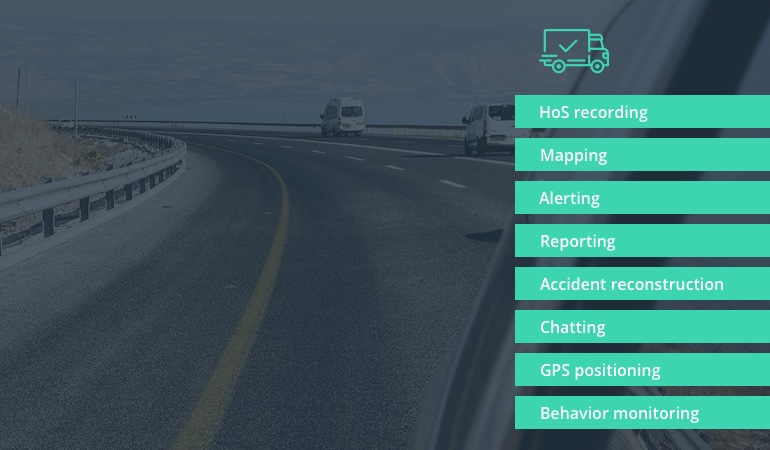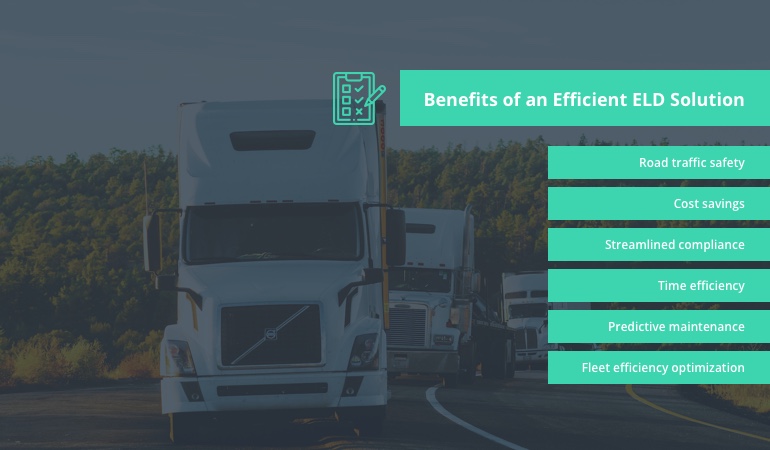To improve road-traffic safety and streamline the monitoring of long-haul truck drivers across the US, the Federal Motor Carrier Safety Administration (FMCSA) issued the ELD mandate. It requires transport operators to equip their fleet with electronic logging devices or ELDs to control drivers’ hours of service. And just like any other advanced solution, this smart device depends largely on the efficiency of the software that enables its operation.
Let’s take a look at what core considerations to follow to create a full-fledged ELD solution.
What is an ELD solution?
An ELD solution is a portable device that records a driver’s hours of service (HoS) and duty status by synchronizing with the vehicle’s engine. The solution comprises a mobile application for the driver, fleet management software for the dispatcher and a telematics appliance that connects to the engine control module.

There are two types of ELD solutions:
- An all-in-one package that includes portables with pre-installed applications both for drivers and freight forwarders
- Software that can be installed on portables that drivers and freight forwarders already use
ELD solutions with the fleet video telematics must comply with the requirements provided in the mandate and must be registered with FMCSA, while the hardware component of the solution must also be certified by the producer.
Benefits of an efficient ELD solution for your business
If for any reason you’re still skeptical of whether you need an ELD solution or not, don’t be: since December 2019, an electronic logging device is a prerequisite, and all trucks must have it. This requirement is based on the advantages that ELDs provide not only to the authorities but also to your business.
It’s easy to guess that carrier companies have a big concern about the high cost of the solution, which in their mind may outweigh the advantages. But we recommend considering ELDs as a wise investment since the benefits from their introduction will certainly recover and surpass the expenses in the long run.

Improved road-traffic safety
Unlike its predecessor — the outdated manual method when drivers recorded their HoS in paper logbooks — ELDs communicate directly with the engine and use its operation as reference. While drivers could easily fake their HoS and duty status on paper logbooks, that’s no longer an option with this independent monitoring device.
So now, they can’t drive longer hours than they are allowed to, which significantly reduces the risk of traffic accidents caused by fatigue. It reduces the road toll in the first place, as well as financial damage.
Cost savings
Risk mitigation for traffic accidents saves companies from severe financial losses usually incurred by servicing of wrecked vehicles, compensation to victims or excessive insurance fees. Moreover, ELDs as monitoring devices compel drivers to use fuel and vehicles rationally, which also results in considerable cost savings.
Streamlined compliance
Drivers no longer have to fill in paper logbooks and office personnel no longer check those logs, which simplifies compliance with the mandate and FMCSA’s provisions. Truck e-logs not only spare personnel from processing reports but also facilitate and accelerate reporting to regulatory authorities.
Time efficiency
E-log apps not only facilitate reporting and compliance, but they also contribute to good time management. According to FMCSA’s estimations, paperwork would take up to 15 minutes per day, which is approximately 90 hours per year. Moreover, ELDs provide accurate data, while manual reporting relied on rounding, which would waste more than five hours per week.
Also, roadside inspections used to be time-consuming, and automatic reports address this issue.
Predictive maintenance
ELDs are permanently connected to vehicles’ motors, which is why they can detect the slightest malfunction before it becomes evident. This helps companies take proactive measures and maintain the engine before it’s out of order, thus keeping related expenses and downtime to a minimum.
Fleet efficiency optimization
ELD devices provide real-time data on fleet usage, disposition, a driver’s duty status, engine condition and other, which allows companies to optimize itineraries and driver engagement for higher productivity.
E-logging devices enable easy communication between drivers and dispatchers, which also improves fleet efficiency.
How to develop ELD software: Core functionality
Now that you’re convinced that a robust electronic logging device (ELD) application is a must, let’s figure out what functionality it should have. For smart devices, software should be well-thought-out and reliable and should transform a mediocre application into an efficient ELD fleet app.

Hours of service recording and alerting
An ELD must record hours of service and duty statuses accurately and without delays. There are “on-duty,” “on-duty not driving,” and “off-duty” statuses. As a rule, the default status is “on-duty not driving,” and the “on-duty” status activates as soon as the engine is started.
To prevent form and manner violations, an ELD application sends audio notifications to the driver sometime before a violation occurs. If the driver waives the permitted hours of service despite the notification, the freight forwarder receives an alert.
An ELD device records not only hours of service and duty statuses but also a driver’s ID, the time, date, speed, mileage, and carrier details. Every 24 hours, a driver must confirm this information.
Automatic IFTA and DVIR reporting
ELD applications automatically report required data, such as mileage and fuel consumption, to IFTA (International Fuel Tax Agreements). This essential ELD system functionality significantly facilitates the process of reporting to transportation companies, and, what’s more important, maintaining timely payment of fuel taxes. With this feature, drivers no longer need to be obsessed with collecting receipts from filling the tank, as everything is automatically tracked.
Automatic driver vehicle inspection reporting (DVIR) not only serves to maintain a vehicle in working order but also to prevent it from getting into accidents due to equipment disruptions. ELD systems for trucksautomatically inspect brakes, tires, and lights as well as detect any mechanical disruptions that need to be checked.
Chatting
Direct messages and group chats are key to maintaining uninterrupted communication between drivers and freight forwarders. Communication of drivers with freight forwarders is crucial, as it allows fleet managers to provide an instant warning on delays or other possible incidents during a trip.
Moreover, electronic logging device (ELD) software is a great solution for drivers, dispatchers, and freight forwarders to be on the same page. In case of a location change, time delay, or other last-minute changes, all parties remain informed and notified, which leads to smooth transportation.
Mapping and GPS positioning
A transportation solution without maps and GPS is unimaginable. Mapping and GPS functionality provides real-time information on itineraries, traffic conditions, rest areas, gas stations, auto repair services, and more.
It also allows dispatchers to supervise fleet navigation via a GPS asset tracking system and record a driver’s speed, direction, and real-time location. Moreover, ELD GPS tracking functionality is a magical wand in case of vehicle theft.
Mapping in ELD systems is a significant logistical approach, as it helps in planning the trip considering weight limits on highways, construction areas, and speed limits.
Driver behavior monitoring
Electronic logging device (ELD) software also includes a non-essential but useful feature to monitor a driver’s behavior by providing freight forwarders with information on uneconomical or unsafe driving.
Once a driving violation has been detected, the engine communicates to the app, informing the freight forwarder of the issue. Soon after the problem is identified, manager can speak with the driver to address the behavioral problem.
This functionality in ELD fleet management software prevents drivers from getting into accidents that may occur due to extreme fatigue, exceeding the speed limit, or violating hours of service rules.
Accident reconstruction
This feature helps companies understand the nature of and reasons for accidents. An ELD tracking systemworks by having a telematics device read data from the accelerometer and speed profile.
Another benefit of this feature is that it allows fleet managers to identify the guilty party in the event of an accident. Driver log software may identify precise details like braking path, speed, and throttle using data from the driver’s GPS.
How to develop ELD software: Technical capabilities
To add value to your business, you not only need to equip your ELD solution with advanced functionality but also ensure that its technical implementation is well-designed. Consider the following technical requirements to know how to make a high-quality ELD system for trucks:
- Driver status changes should be available in the form of an insightful graph that can be viewed on the display or printed out. This feature of truck log software is key to analyzing a driver’s workload to detect if the driver is overworking or demonstrates a shortage of working hours.
- Hours of service (HoS) data should comply with standards for easy reporting to regulatory authorities. According to the Large Truck Crash Causation Study (LTCCS) report, approximately 13% of truck drivers involved in road incidents experience extreme fatigue. Tracking HoS for trucks is mandatory for the freight industry to maintain road safety and efficient driver performance.
- There should be a hard-wired connection to the engine control unit for higher reliability and data accuracy. Without a doubt, the 21st century is an era of wireless connections; however, to achieve precision and accurate information on the proper mechanical functioning of a truck, a hard-wired backup in the ELD mandate software is a must.
- Support for a Wi-Fi connection and Bluetooth is necessary for streamlined communication and reporting. This is a crucial technical feature that allows for keeping in touch with drivers despite long distances and in hard-to-reach areas.
- The system should be compatible with Android and iOS operating systems. It’s necessary to customize trucking logbook software in order to expand the number of users and enable the freight industry to actively use it.
- Plug-and-play installation. Simplifying a driver’s daily routine is possible with easy plug-and-play installation that allows for plugging in a device and receiving all the necessary engine information.
- Data should be retained for seven days and displayed on demand. In order to analyze a driver’s behavior, HoS, and activity statuses as well as to record the mechanical health of the vehicle, it’s necessary to retain data. Further, this data is to be used by fleet managers to enhance the efficiency of the process and avoid monetary losses.
- UTC (Coordinated Universal Time) synchronization is a must for an electronic logging system to avoid timing compliance malfunctions and ensure proper date tracking for the driver’s home terminal.
Prioritize reliability
Whether you need a comprehensive ELD solution that comprises a dozen features or one with just the basic features, you should definitely go the extra mile and ensure its reliable performance. Don’t know how to do that? Contact Intellias and we’ll help you create a reliable full-fledged ELD and fleet management solution that will add value to your business.




